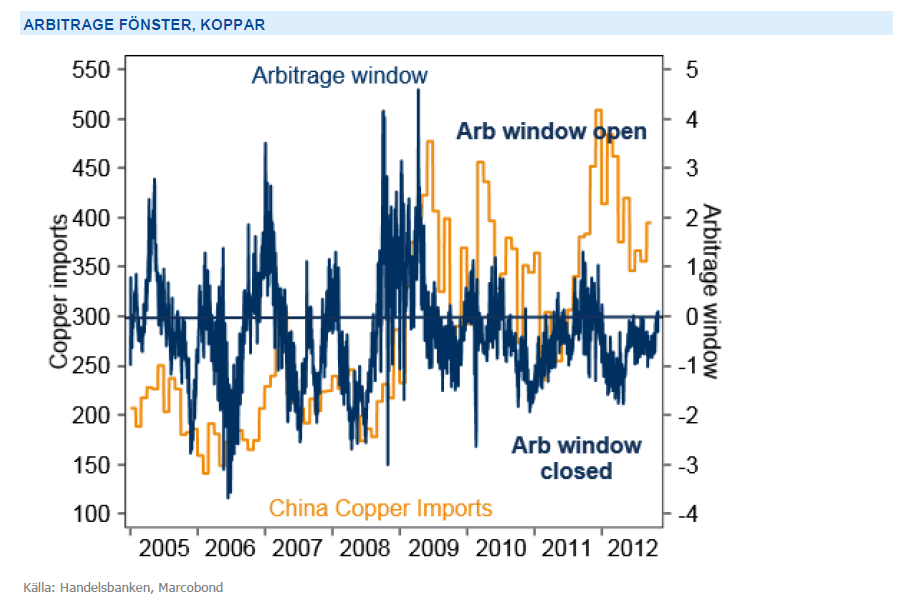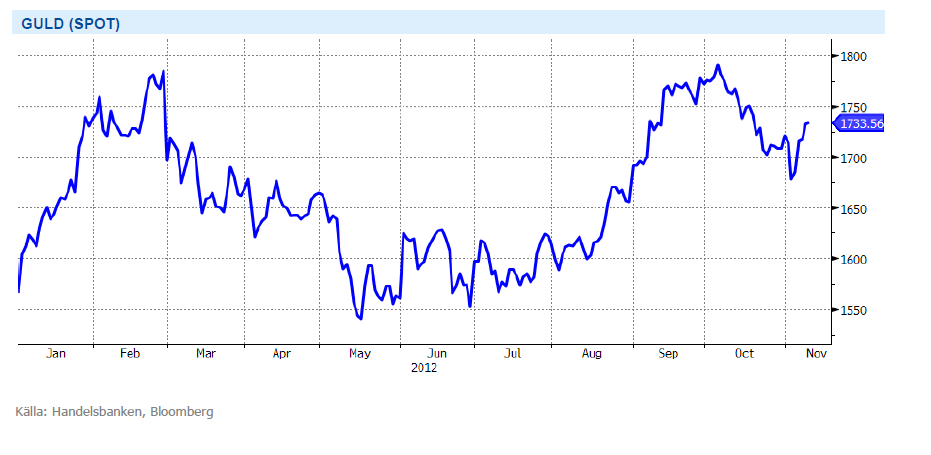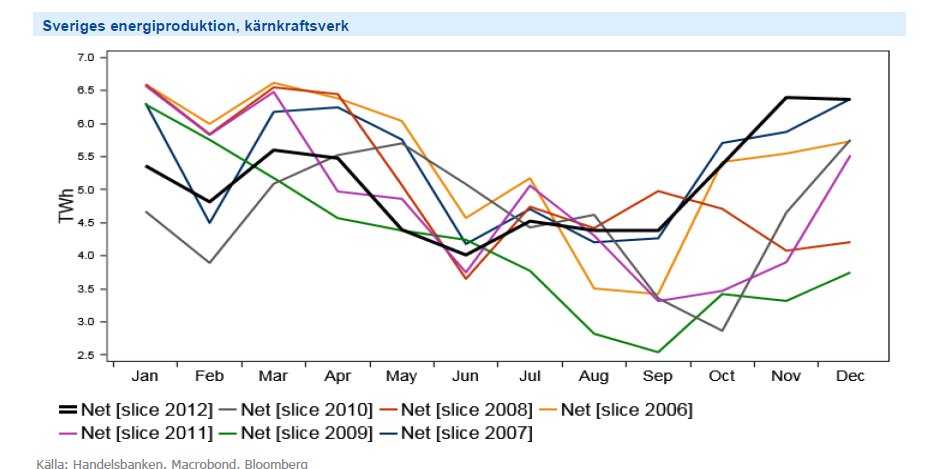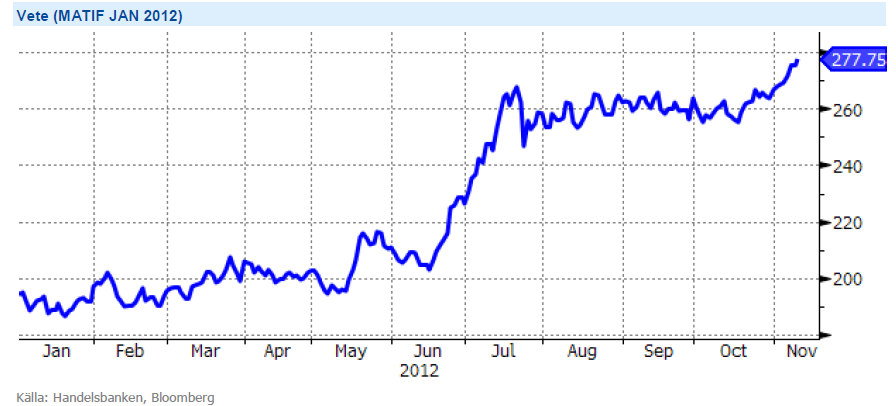Analys
SHB Råvarubrevet 9 november 2012
 Iskall konjunkturell vinter i Sverige – men gröna bambuskott i Kina
Iskall konjunkturell vinter i Sverige – men gröna bambuskott i Kina
Risksentimentet har haft det kämpigt de senaste veckorna, trots gröna skott i Kina och USA. Marknaden har åter tvingats fokusera på Grekland och Spanien, mestadels tack vare sedvanligt politiskt käbbel. Samtidigt har oron kring det finanspolitiska stupet kommit som ett brev på posten efter USA:s presidentval.
Förra året enades USA:s politiker bland annat om att tillfälligt förlänga de skattelättnader som infördes av Bush 2001-03. Utöver dessa kommer också ökat skattetryck från Obamas sjukvårdspaket. Sammantaget skulle oförändrad finanspolitik motsvara skattehöjningar och utgiftsminskningar på nära 4 % av BNP nästa år. Med dagens tillväxttakt på drygt 2 % skulle ett fall utför budgetstupet föra USA in i en ny recession. Vi räknar emellertid med att det politiska systemet lyckas komma överrens, måhända under årets sista skälvande timmar. På fredagsmorgonen kom bra oktoberdata från Kina som styrker vår positiva syn på basmetaller och som bekräftar att vändningen i den kinesiska konjunkturen i september fortsätter. Grekkaos och fiscal cliff spred dock smolk i glädjebägaren. Samtidigt har det kommit mycket dålig data från Sverige men den ska man inte tolka som negativt för råvarorna som handlas på världsmarknaden.
Basmetallerna
Kinas återhämtning finns framför oss
Basmetallerna startade veckan med stigande priser men vände ned igen då dollar stärktes efter valet i USA. Från måndagens öppning stänger kopparn på -1,1 %, aluminium är ned med 0,6 % medan nickel är princip oförändrad. Imorse fick vi dock positiv data från Kina där industriproduktionen kom in på 9,6 % (väntat 9,4%) i oktober jämfört med 9,2% i september och investeringar (FAI) YTD kom in på 20,7 % (väntat 20,6%) mot 20,5% i september.
Kopparlagren i Kina (både bonded och SHFE) är på rekordnivåer och trots att Kina importerat mycket de senaste månaderna har lagren utanför Kina inte minskat vilket vittnar om en fortsatt svag konsumtion globalt (ex Kina). Totala lager ligger nu på ca 1.2 miljoner ton (+0.3 miljoner ton sen i somras) men vi förväntar oss att överskottet reduceras något mot slutet av året/inledningen av 2013 i takt med att kinesiska verk nu betat av sina lager och börjar bygga upp nya. Kopparbalansen ser vidare ut att bli negativ under 2013 för första gången på tre år. Arbitragefönstret mellan Shanghai och LME åter öppet (se blå graf nedan som nu är positiv) vilket bör ge stöd åt Kinesisk import och kopparpriset. Vi behåller vår positiva vy för basmetaller.
Under oktober har basmetallerna haft ett kraftigt ras, efter den kraftiga uppgången i september. Finansmarknaden hade handlat in för mycket på för kort tid. Däremot ser Kinadata allt bättre ut nu. Vi tror på: Vi tror på: BASMET H
Ädelmetaller
Fiscal cliff stärker guldet
Ädelmetallerna har hämtat sig från förra veckans fall, och Handelsbankens ädelmetallindex har stigit med nästan 3 % sedan fredagens stängning. Med en omvald Barack Obama i vita huset är diskussionen kring fiscal cliff (finanspolitiska stupet) åter på agendan vilket har fått guldet att stiga i värde. Fiscal cliff tillsammans med förnyad oro kring eurokrisen ökar investerares vilja att fly till guldet. Guldet handlas nu på 1733 USD/uns, vilket är 3,3 % högre än veckans öppning.
I och med att Obama blev omvald så är chanserna för fortsatt mjuk penningpolitik mycket större än om Romney blivit vald till USA:s president vilket talar till guldets fördel. Vi behåller vår positiva vy för hela sektorn.
Rapporterna kring strejkerna i de sydafrikanska gruvorna har tystnat, vilket tyder på att situationen återgått till det normala – dock med betydligt färre arbetare i gruvorna.
Vi är fortsatt positiva till ädelmetaller med den främsta anledningen att vi tror på fortsatt mjuk penningpolitik från FED och att central bankernas stimulanser forstätter att ge stöd. Vi tror på: ADELMET H
Energi
Fortsatt bensinbrist i USA
Omvalet av Barack Obama som USA:s president har inte haft något tydlig inverkan på oljepriset. Däremot är det fortfarande bensinbrist i spåren efter stormen Sandy, endast en fjärdedel av bensinstationerna i New York City, Long Island och New Jersey är i drift. Nu sätts åtgärder in för att försöka lindra problemet. Det beredskapslager som inrättades 2000 öppnas nu energidepartementet. Försvaret har fått i uppgift att köpa in och distribuera inte mindre än 380 000 fat blyfri bensin och 317 000 fat diesel till de berörda områdena. Brent-oljan handlas i skrivande stund på 107 USD/fat vilket är 1,15 % högre än måndagens öppning, i onsdag handlas dock oljan upp på dryga 111 USD/fat.
Marginellt ned på elmarknaden under veckan och även om vi inte förväntar oss några större rörelser är sentimentet fortsatt svagt. Såväl kol som utsläppsrätter handlas oförändrat och ser vi till vädret förväntas temperaturen ligga en ca 3 grader över normalt de kommande tio dagarna medan nederbördsmängderna beräknas till ca 7 TWh vilket är normalt denna tid på året. En del av den förväntade nederbörden uteblev vilket innebär att energibalansen minskar till ca 8.5 TWh. Svensk kärnkraft går mot bästa novemberproduktionen sedan Barsebäck stängdes (maj 2005) och december kan bli ännu bättre då vår tionde och minsta reaktor, Oskarshamn 1, fortfarande står stilla. Övriga 9 reaktorer är nu igång efter årets revision (underhåll) och då är risken mycket liten att de inte levererar i vinter. Notera den bedrövliga vintern 09/10 i bilden nedan.
Oljan har sett allt svagare ut och vi fortsätter tycka att underliggande fundamenta är väl balanserad. Vi ser även att förutsättningarna för fortsatt lågt elpris kvarstår. Vi håller en neutral syn på energisektorn.
Livsmedel
Global veteproduktion väntas justeras ned
Terminspriser på vete har gått upp sedan förra veckan i både Chicago och Paris. Det amerikanska höstvetet lider fortfarande av torrt och varmt väder och någon klar bättring ser inte ut att vara i sikte. Skicket på grödan bedöms vara rekorddåligt och ytterligare försämring är nog att vänta. I Argentina har det blivit lite torrare, vilket gynnar pågående skörd. Lite regn har fallit i de östra delarna av Australien, generellt sett är det dock väldigt torrt. Den nederbörd som fallit lär nog inte ha någon större effekt, men bromsar en fortsatt nedgång. I dagens WASDE-rapport från USDA bör produktionssiffrorna för den australiensiska skörden justeras ned från föregående rapports 23 miljoner ton, 20 miljoner ton eller strax därunder är nog mer rimligt.
I EU är det fortfarande blött i en del områden och tiden för sådd löper snart ut. I Frankrike rapporterades tidigare i veckan om att sådden var avklarad endast till 64 procent, att jämföra med 88 procent vid samma tid förra året. Än värre är det i Storbritannien där det nu talas om att höstsådden kanske inte når mycket mer än 60 procent av tidigare planerad areal. I dagens WASDE-rapport väntas inga större förändringar för det amerikanska vetet. För den globala produktionen väntas däremot nedjusteringar för främst Australien och Argentina – förmodligen dock inte till fullt så låga nivåer som de lokala analytikernas utan kvar något över likt föregående månad. Med försämrade förutsättningar för nästa års skörd bör en eventuell nedsida vara väldigt begränsad. En bra start på grödan är givetvis att föredra men mycket kan hända tills nästa års skörd och vi har sett förr att de höstsådda grödorna återhämtat sig väl efter vintern.
Vi ser soja, majs och vete som klara säljcase där vi väntar oss prisfall före jul men senast till påsk. Vi tror på: LIVSMEDEL S H
Handelsbankens Råvaruindex
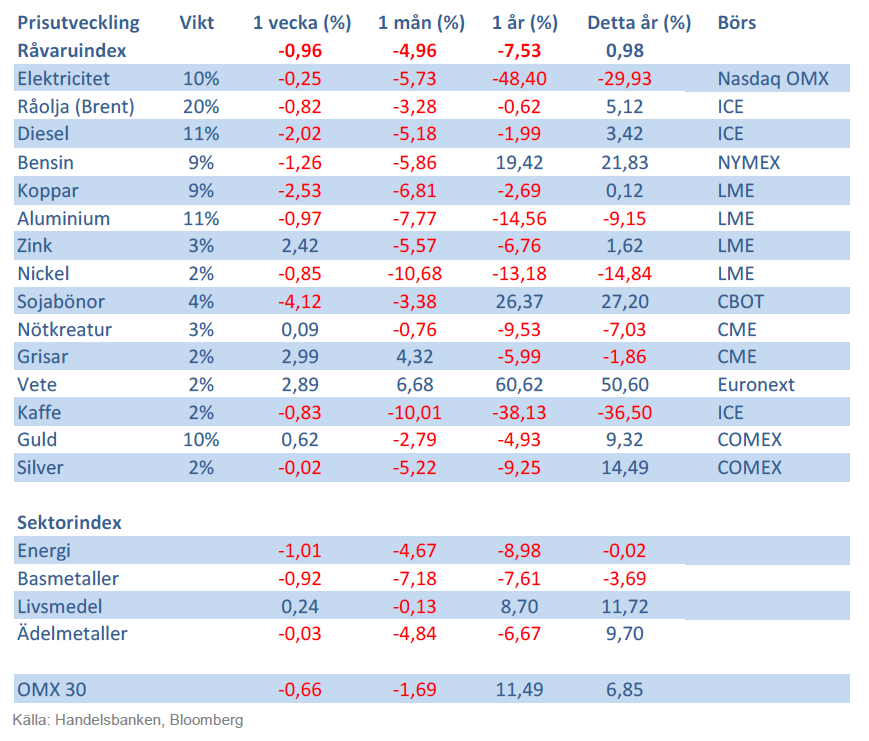
Handelsbankens råvaruindex består av de underliggande indexen för respektive råvara. Vikterna är bestämda till hälften från värdet av global produktion och till hälften från likviditeten i terminskontrakten.
[box]SHB Råvarubrevet är producerat av Handelsbanken och publiceras i samarbete och med tillstånd på Råvarumarknaden.se[/box]
Ansvarsbegränsning
Detta material är producerat av Svenska Handelsbanken AB (publ) i fortsättningen kallad Handelsbanken. De som arbetar med innehållet är inte analytiker och materialet är inte oberoende investeringsanalys. Innehållet är uteslutande avsett för kunder i Sverige. Syftet är att ge en allmän information till Handelsbankens kunder och utgör inte ett personligt investeringsråd eller en personlig rekommendation. Informationen ska inte ensamt utgöra underlag för investeringsbeslut. Kunder bör inhämta råd från sina rådgivare och basera sina investeringsbeslut utifrån egen erfarenhet.
Informationen i materialet kan ändras och också avvika från de åsikter som uttrycks i oberoende investeringsanalyser från Handelsbanken. Informationen grundar sig på allmänt tillgänglig information och är hämtad från källor som bedöms som tillförlitliga, men riktigheten kan inte garanteras och informationen kan vara ofullständig eller nedkortad. Ingen del av förslaget får reproduceras eller distribueras till någon annan person utan att Handelsbanken dessförinnan lämnat sitt skriftliga medgivande. Handelsbanken ansvarar inte för att materialet används på ett sätt som strider mot förbudet mot vidarebefordran eller offentliggörs i strid med bankens regler.
Analys
Tightening fundamentals – bullish inventories from DOE

The latest weekly report from the US DOE showed a substantial drawdown across key petroleum categories, adding more upside potential to the fundamental picture.

Commercial crude inventories (excl. SPR) fell by 5.8 million barrels, bringing total inventories down to 415.1 million barrels. Now sitting 11% below the five-year seasonal norm and placed in the lowest 2015-2022 range (see picture below).
Product inventories also tightened further last week. Gasoline inventories declined by 2.1 million barrels, with reductions seen in both finished gasoline and blending components. Current gasoline levels are about 3% below the five-year average for this time of year.
Among products, the most notable move came in diesel, where inventories dropped by almost 4.1 million barrels, deepening the deficit to around 20% below seasonal norms – continuing to underscore the persistent supply tightness in diesel markets.
The only area of inventory growth was in propane/propylene, which posted a significant 5.1-million-barrel build and now stands 9% above the five-year average.
Total commercial petroleum inventories (crude plus refined products) declined by 4.2 million barrels on the week, reinforcing the overall tightening of US crude and products.


Analys
Bombs to ”ceasefire” in hours – Brent below $70

A classic case of “buy the rumor, sell the news” played out in oil markets, as Brent crude has dropped sharply – down nearly USD 10 per barrel since yesterday evening – following Iran’s retaliatory strike on a U.S. air base in Qatar. The immediate reaction was: “That was it?” The strike followed a carefully calibrated, non-escalatory playbook, avoiding direct threats to energy infrastructure or disruption of shipping through the Strait of Hormuz – thus calming worst-case fears.

After Monday morning’s sharp spike to USD 81.4 per barrel, triggered by the U.S. bombing of Iranian nuclear facilities, oil prices drifted sideways in anticipation of a potential Iranian response. That response came with advance warning and caused limited physical damage. Early this morning, both the U.S. President and Iranian state media announced a ceasefire, effectively placing a lid on the immediate conflict risk – at least for now.
As a result, Brent crude has now fallen by a total of USD 12 from Monday’s peak, currently trading around USD 69 per barrel.
Looking beyond geopolitics, the market will now shift its focus to the upcoming OPEC+ meeting in early July. Saudi Arabia’s decision to increase output earlier this year – despite falling prices – has drawn renewed attention considering recent developments. Some suggest this was a response to U.S. pressure to offset potential Iranian supply losses.
However, consensus is that the move was driven more by internal OPEC+ dynamics. After years of curbing production to support prices, Riyadh had grown frustrated with quota-busting by several members (notably Kazakhstan). With Saudi Arabia cutting up to 2 million barrels per day – roughly 2% of global supply – returns were diminishing, and the risk of losing market share was rising. The production increase is widely seen as an effort to reassert leadership and restore discipline within the group.
That said, the FT recently stated that, the Saudis remain wary of past missteps. In 2018, Riyadh ramped up output at Trump’s request ahead of Iran sanctions, only to see prices collapse when the U.S. granted broad waivers – triggering oversupply. Officials have reportedly made it clear they don’t intend to repeat that mistake.
The recent visit by President Trump to Saudi Arabia, which included agreements on AI, defense, and nuclear cooperation, suggests a broader strategic alignment. This has fueled speculation about a quiet “pump-for-politics” deal behind recent production moves.
Looking ahead, oil prices have now retraced the entire rally sparked by the June 13 Israel–Iran escalation. This retreat provides more political and policy space for both the U.S. and Saudi Arabia. Specifically, it makes it easier for Riyadh to scale back its three recent production hikes of 411,000 barrels each, potentially returning to more moderate increases of 137,000 barrels for August and September.
In short: with no major loss of Iranian supply to the market, OPEC+ – led by Saudi Arabia – no longer needs to compensate for a disruption that hasn’t materialized, especially not to please the U.S. at the cost of its own market strategy. As the Saudis themselves have signaled, they are unlikely to repeat previous mistakes.
Conclusion: With Brent now in the high USD 60s, buying oil looks fundamentally justified. The geopolitical premium has deflated, but tensions between Israel and Iran remain unresolved – and the risk of missteps and renewed escalation still lingers. In fact, even this morning, reports have emerged of renewed missile fire despite the declared “truce.” The path forward may be calmer – but it is far from stable.
Analys
A muted price reaction. Market looks relaxed, but it is still on edge waiting for what Iran will do

Brent crossed the 80-line this morning but quickly fell back assigning limited probability for Iran choosing to close the Strait of Hormuz. Brent traded in a range of USD 70.56 – 79.04/b last week as the market fluctuated between ”Iran wants a deal” and ”US is about to attack Iran”. At the end of the week though, Donald Trump managed to convince markets (and probably also Iran) that he would make a decision within two weeks. I.e. no imminent attack. Previously when when he has talked about ”making a decision within two weeks” he has often ended up doing nothing in the end. The oil market relaxed as a result and the week ended at USD 77.01/b which is just USD 6/b above the year to date average of USD 71/b.

Brent jumped to USD 81.4/b this morning, the highest since mid-January, but then quickly fell back to a current price of USD 78.2/b which is only up 1.5% versus the close on Friday. As such the market is pricing a fairly low probability that Iran will actually close the Strait of Hormuz. Probably because it will hurt Iranian oil exports as well as the global oil market.
It was however all smoke and mirrors. Deception. The US attacked Iran on Saturday. The attack involved 125 warplanes, submarines and surface warships and 14 bunker buster bombs were dropped on Iranian nuclear sites including Fordow, Natanz and Isfahan. In response the Iranian Parliament voted in support of closing the Strait of Hormuz where some 17 mb of crude and products is transported to the global market every day plus significant volumes of LNG. This is however merely an advise to the Supreme leader Ayatollah Ali Khamenei and the Supreme National Security Council which sits with the final and actual decision.
No supply of oil is lost yet. It is about the risk of Iran closing the Strait of Hormuz or not. So far not a single drop of oil supply has been lost to the global market. The price at the moment is all about the assessed risk of loss of supply. Will Iran choose to choke of the Strait of Hormuz or not? That is the big question. It would be painful for US consumers, for Donald Trump’s voter base, for the global economy but also for Iran and its population which relies on oil exports and income from selling oil out of that Strait as well. As such it is not a no-brainer choice for Iran to close the Strait for oil exports. And looking at the il price this morning it is clear that the oil market doesn’t assign a very high probability of it happening. It is however probably well within the capability of Iran to close the Strait off with rockets, mines, air-drones and possibly sea-drones. Just look at how Ukraine has been able to control and damage the Russian Black Sea fleet.
What to do about the highly enriched uranium which has gone missing? While the US and Israel can celebrate their destruction of Iranian nuclear facilities they are also scratching their heads over what to do with the lost Iranian nuclear material. Iran had 408 kg of highly enriched uranium (IAEA). Almost weapons grade. Enough for some 10 nuclear warheads. It seems to have been transported out of Fordow before the attack this weekend.
The market is still on edge. USD 80-something/b seems sensible while we wait. The oil market reaction to this weekend’s events is very muted so far. The market is still on edge awaiting what Iran will do. Because Iran will do something. But what and when? An oil price of 80-something seems like a sensible level until something do happen.
-

 Nyheter4 veckor sedan
Nyheter4 veckor sedanStor uppsida i Lappland Guldprospekterings aktie enligt analys
-

 Nyheter4 veckor sedan
Nyheter4 veckor sedanSilverpriset släpar efter guldets utveckling, har mer uppsida
-

 Nyheter3 veckor sedan
Nyheter3 veckor sedanUppgången i oljepriset planade ut under helgen
-

 Nyheter2 veckor sedan
Nyheter2 veckor sedanMahvie Minerals växlar spår – satsar fullt ut på guld
-

 Nyheter3 veckor sedan
Nyheter3 veckor sedanLåga elpriser i sommar – men mellersta Sverige får en ökning
-

 Analys3 veckor sedan
Analys3 veckor sedanVery relaxed at USD 75/b. Risk barometer will likely fluctuate to higher levels with Brent into the 80ies or higher coming 2-3 weeks
-

 Nyheter2 veckor sedan
Nyheter2 veckor sedanOljan, guldet och marknadens oroande tystnad
-

 Nyheter2 veckor sedan
Nyheter2 veckor sedanJonas Lindvall är tillbaka med ett nytt oljebolag, Perthro, som ska börsnoteras



